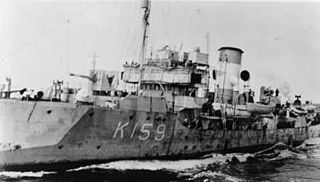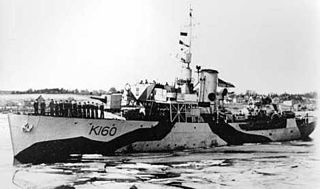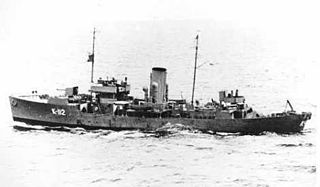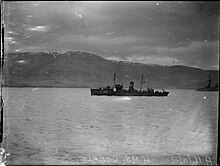
HMCS Buctouche was a Flower-class corvette that served in the Royal Canadian Navy (RCN) during the Second World War. She served primarily in the Battle of the Atlantic as a convoy escort. She was named for Bouctouche, New Brunswick.

HMCS Regina was a Royal Canadian Navy revised Flower-class corvette which took part in convoy escort duties during the Second World War. She fought primarily in the Battle of the Atlantic. She was named for Regina, Saskatchewan.

HMCS Brantford was a Flower-class corvette that served in the Royal Canadian Navy during the Second World War. She served primarily as a convoy escort in the Battle of the Atlantic. She was named for Brantford, Ontario.

HMCS Wetaskiwin was a Flower-class corvette of the Royal Canadian Navy that served during the Second World War. She served primarily as a convoy escort in the Battle of the Atlantic. She was named after the city of Wetaskiwin, Alberta. Wetaskiwin was the first Pacific coast built corvette to enter service with the Royal Canadian Navy.

HMCS Napanee was a Flower-class corvette of the Royal Canadian Navy during the Second World War. She saw service primarily in the Battle of the Atlantic as a convoy escort. She is named after Napanee, Ontario.

HMCS Prescott was a Flower-class corvette of the Royal Canadian Navy during the Second World War. She served primarily in the Battle of the Atlantic as a convoy escort. She was named for Prescott, Ontario.

HMCS Dunvegan was a Flower-class corvette that served with the Royal Canadian Navy during the Second World War. She served primarily in the Battle of the Atlantic. After the war she was sold to the Venezuelan Navy. She was named for Dunvegan, Inverness County, Nova Scotia.

HMCS Fennel was a Flower-class corvette that served primarily with the Royal Canadian Navy during the Second World War. Originally commissioned into the Royal Navy, she served as an ocean escort in the Battle of the Atlantic.

HMCS Hepatica was a Flower-class corvette that served primarily with the Royal Canadian Navy during the Second World War. She saw service in the Battle of the Atlantic as an ocean escort. Originally commissioned into the Royal Navy, she was loaned to Canada in 1941.

HMCS Kamsack was a Flower-class corvette that served with the Royal Canadian Navy during the Second World War. She served primarily in the Battle of the Atlantic as an ocean escort. She was named for Kamsack, Saskatchewan.

HMCS Lethbridge was a Flower-class corvette that served with the Royal Canadian Navy during the Second World War. She served primarily in the Battle of the Atlantic as an ocean escort. She was named for Lethbridge, Alberta.

HMCS Matapedia was a Flower-class corvette that served with the Royal Canadian Navy during the Second World War. She fought primarily in the Battle of the Atlantic as an ocean escort. She was named for Matapédia, Quebec.

HMCS Nanaimo was a Flower-class corvette that served with the Royal Canadian Navy during the Second World War. She served on both coasts during the war. She was named for Nanaimo, British Columbia.

HMCS Saskatoon was a Flower-class corvette that served with the Royal Canadian Navy during the Second World War. She saw service primarily in the Battle of the Atlantic. She is named for Saskatoon, Saskatchewan.

HMCS Sherbrooke was a Flower-class corvette that served with the Royal Canadian Navy during the Second World War. She served primarily in the Battle of the Atlantic as an ocean escort. She is named for Sherbrooke, Quebec.

HMCS Sorel was a Flower-class corvette that served with the Royal Canadian Navy during the Second World War. She served primarily in the Battle of the Atlantic as an ocean escort. She is named for Sorel, Quebec.

HMCS The Pas was a Flower-class corvette that served with the Royal Canadian Navy during the Second World War. She served primarily as an ocean escort in the Battle of the Atlantic and as a training ship. She was named for The Pas, Manitoba.

HMCS Trail was a Flower-class corvette that served with the Royal Canadian Navy during the Second World War. She served primarily in the Battle of the Atlantic as a convoy escort. She was named for Trail, British Columbia.

HMCS Vancouver was a Flower-class corvette that served with the Royal Canadian Navy during the Second World War. She saw action primarily in both Atlantic and Pacific theatres. She was named for Vancouver, British Columbia. She was the second commissioned ship and the third overall to bear the name Vancouver.

HMCS Port Arthur was a Royal Canadian Navy revised Flower-class corvette which took part in convoy escort duties during the Second World War. She fought primarily in the Battle of the Atlantic. She was named for Port Arthur, Ontario.





















